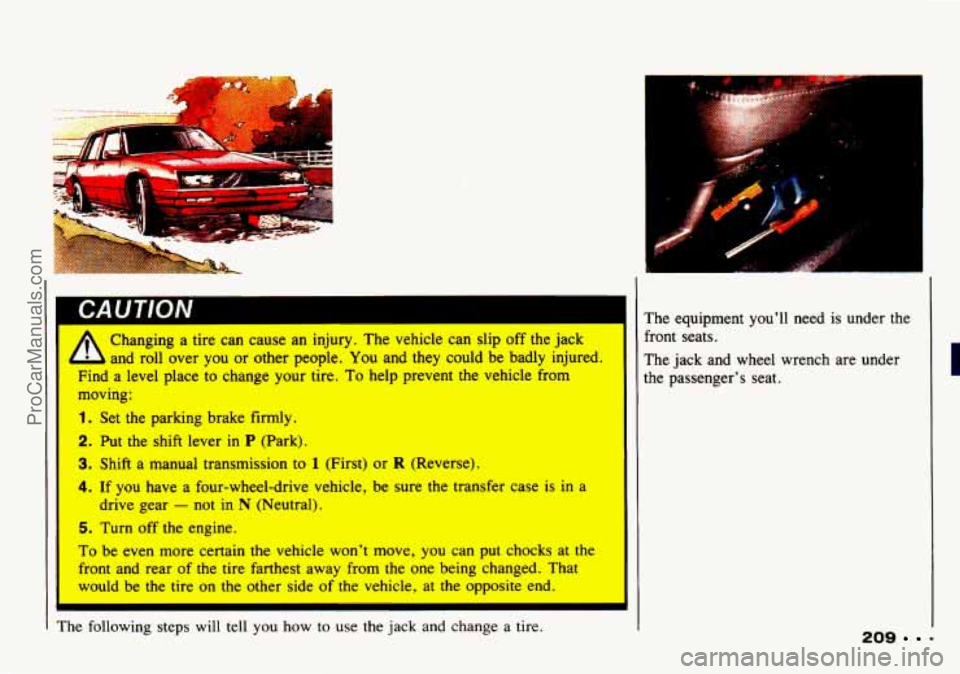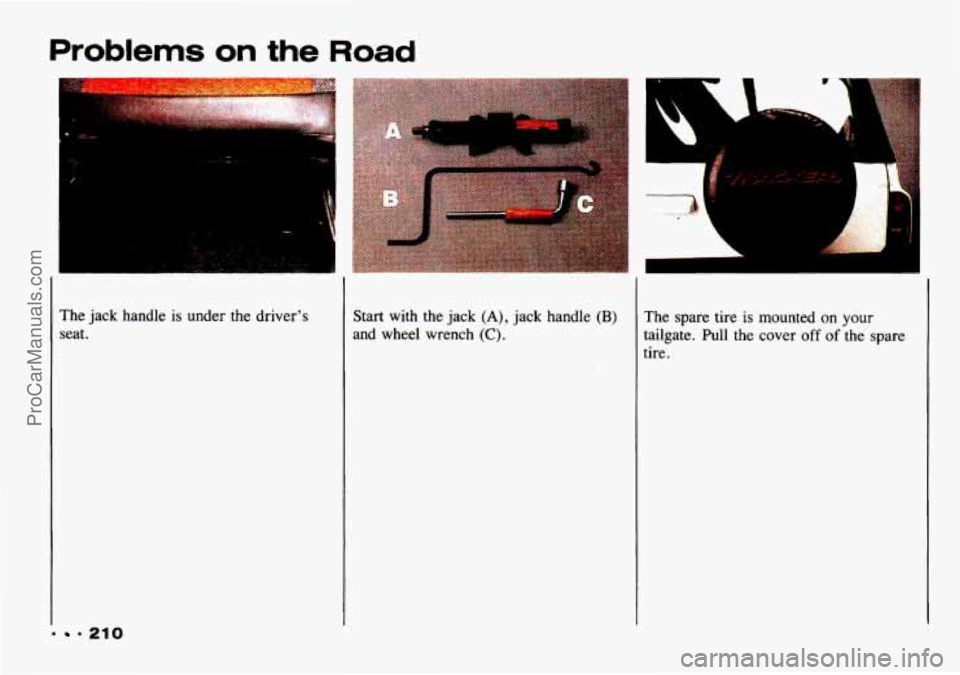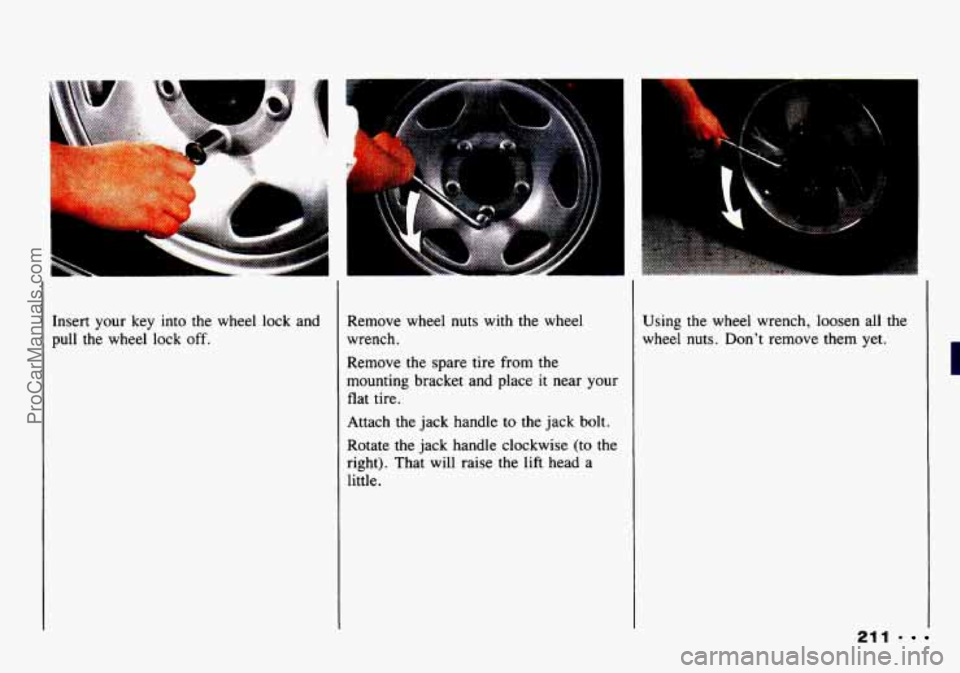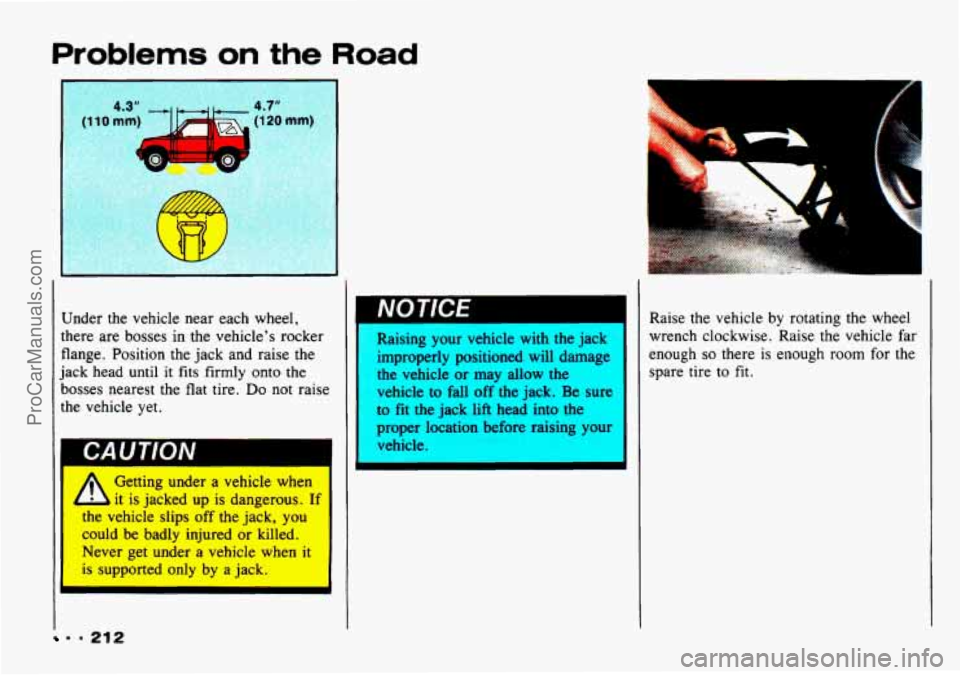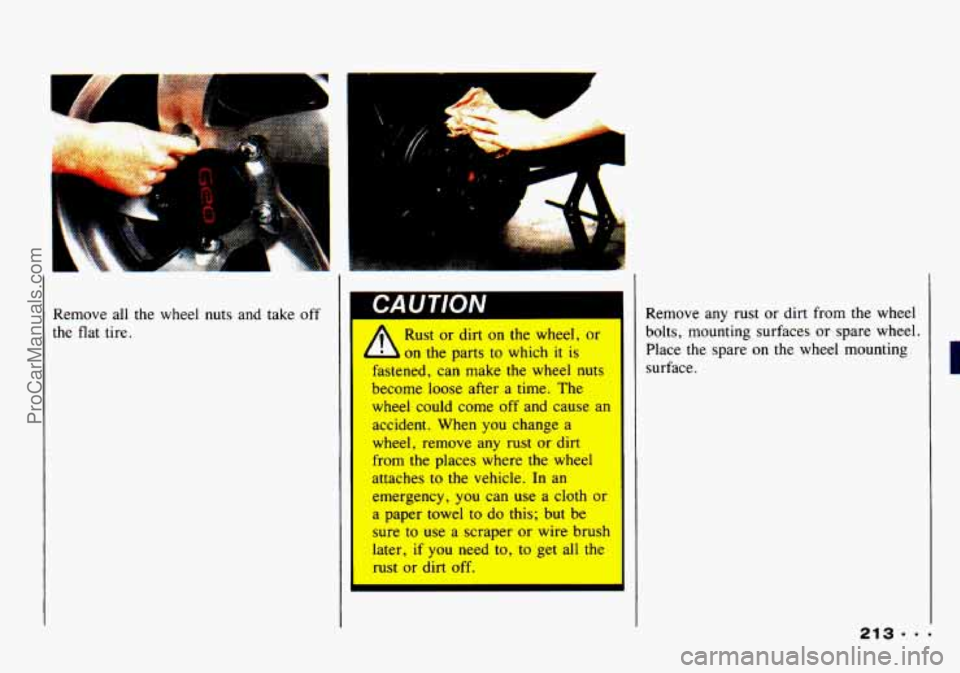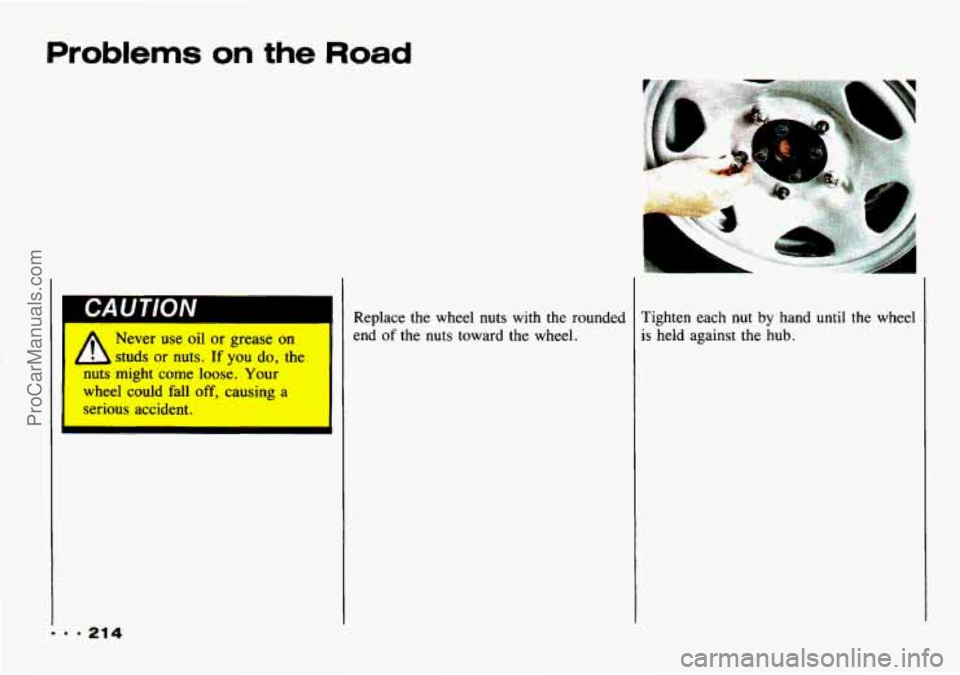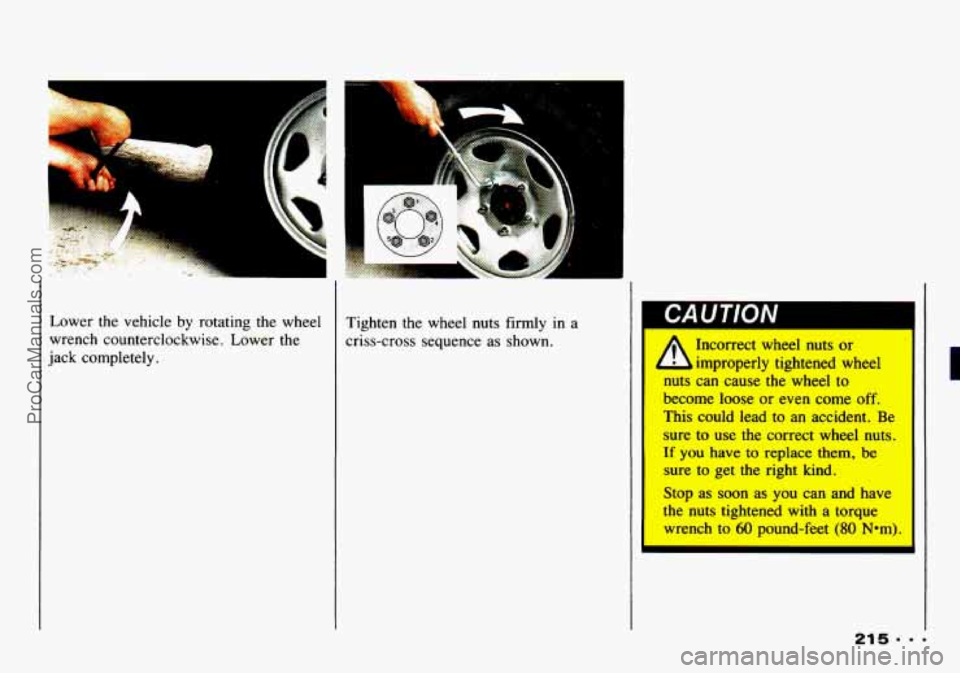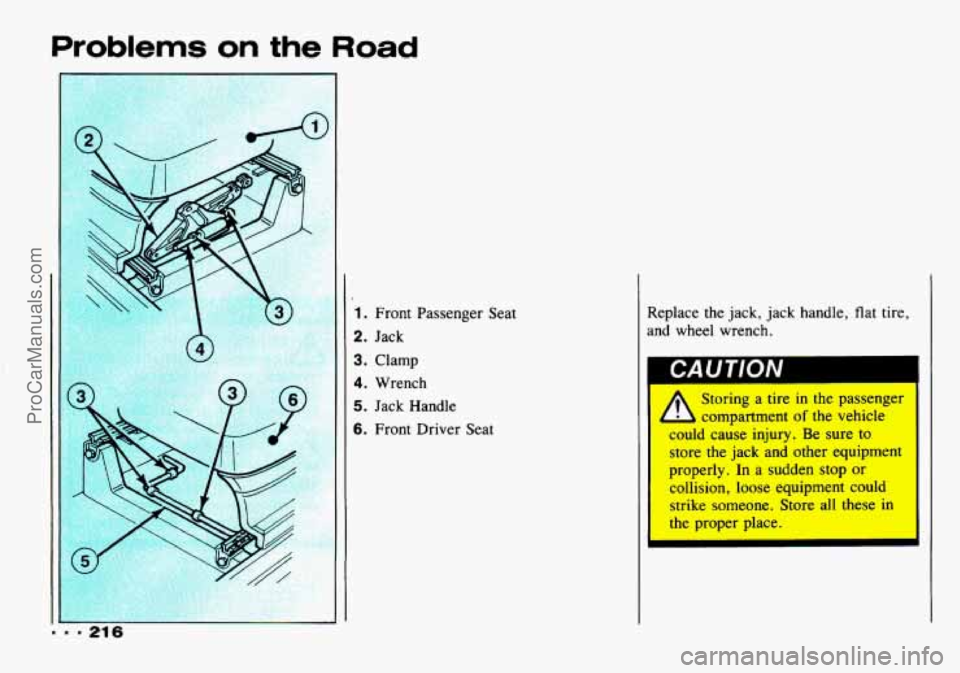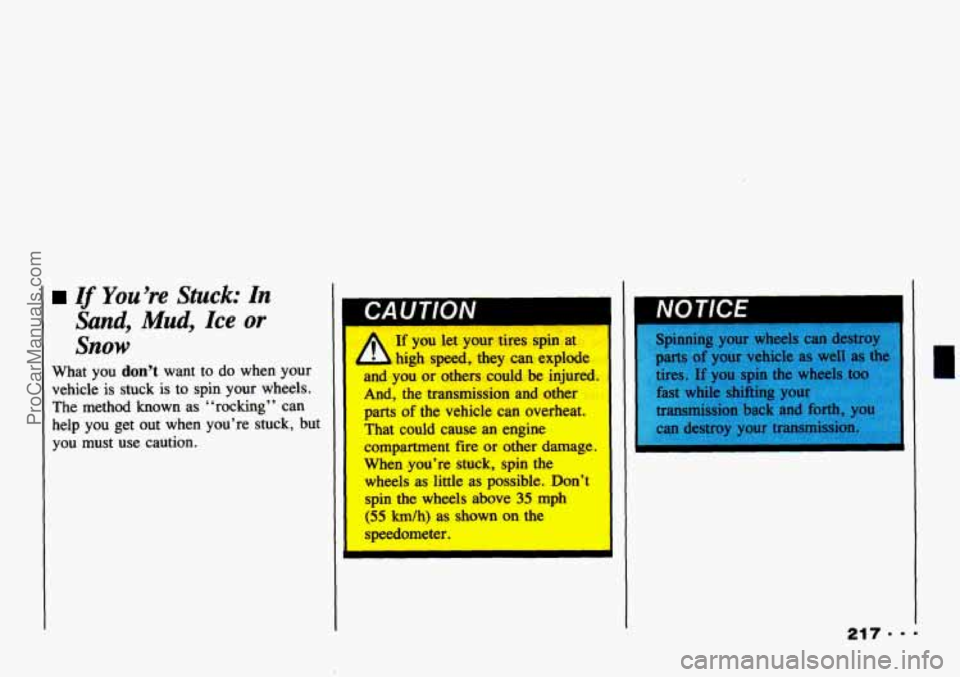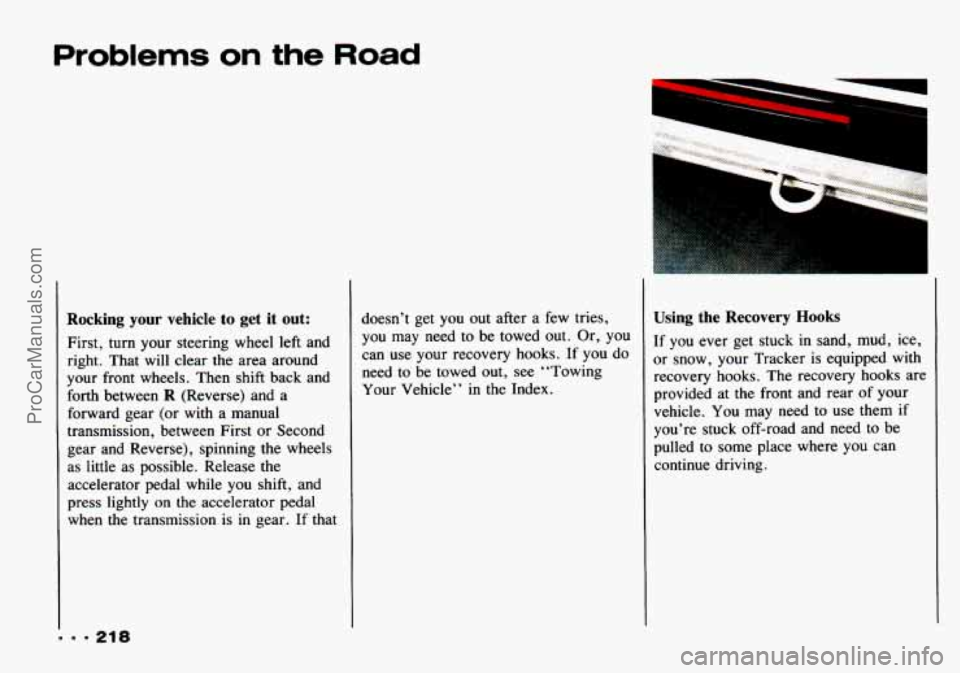CHEVROLET TRACKER 1993 Owners Manual
TRACKER 1993
CHEVROLET
CHEVROLET
https://www.carmanualsonline.info/img/24/57718/w960_57718-0.png
CHEVROLET TRACKER 1993 Owners Manual
Trending: belt, oil capacity, heater, suspension, trailer, load capacity, fuel additives
Page 211 of 339
CAUTION
A
Changing a tire can cause an injury. The vehicle can slip off the jack
and roll over you or other people. You and they could be badly injured.
Find a level place to change your tire.
To help prevent the vehicle from
moving:
1. Set the parking brake firmly.
2. Put the shift lever in P (Park).
3. Shift a manual transmission to 1 (First) or R (Reverse).
4. If you have a four-wheel-drive vehicle, be sure the transfer case is in a
5. Turn off the engine.
To be even more certain the vehicle won’t move, you can put chocks at the
front and rear of the tire farthest away from the one being changed. That
would be the tire on the other side of the vehicle, at the opposite end.
drive gear
- not in N (Neutral).
I The following steps will tell
you how to use the jack and change a tire. The
equipment you’ll need
is under the
front seats.
The jack and wheel wrench are under
the passenger’s seat.
209 =
ProCarManuals.com
Page 212 of 339
The jack handle is under the driver’s
seat.
.210
Start with the jack (A), jack handle (B)
and wheel wrench (C).
The spare tire is mounted on your
tailgate. Pull the cover off of the spare
tire.
ProCarManuals.com
Page 213 of 339
Insert your key into the wheel lock and
pull the wheel lock
off.
Remove wheel nuts with the wheel
wrench.
Remove the spare tire from the
mounting bracket and place it near your
flat tire.
Attach the jack handle to the jack bolt.
Rotate the jack handle clockwise (to the
right). That will raise the lift head a
little. Using
the wheel wrench, loosen all the
wheel nuts. Don’t remove them yet.
211
ProCarManuals.com
Page 214 of 339
Problems on the Road
Under the vehicle near each wheel,
there are bosses in the vehicle’s rocker
flange. Position the jack and raise the
jack head until
it fits firmly onto the
bosses nearest the flat tire.
Do not raise
the vehicle yet.
I
A Getting under a vehicle when
d it is jacked up is dangerous. If
LII~ vehicle slips off the jack, you
could be badly injured or killed.
Never get under
a vehicle when it
is supported only by a jack.
. .212
Raising your vehicle with the jack
improperly positioned will damage
the vehicle
or may allow the
vehicle to fall off the jack. Be sure
to fit the jack lift head into the
proper location before raising your
vehicle. Raise
the vehicle
by rotating the wheel
wrench clockwise. Raise the vehicle far
enough
so there is enough room for the
spare tire to
fit.
ProCarManuals.com
Page 215 of 339
c
Remove all the wheel nuts and take off
the
flat tire.
r '_ .-
Rust or dirt on the wheel, or
on the parts to which it is
fastened, can make the wheel nuts
become loose after a time. The
wheel could come off and cause an
accident. When you change a
wheel, remove any rust or dirt
from the places where the wheel
attaches
to the vehicle. In an
emergency, you can use a cloth or
a paper towel to do this; but be
sure to use a scraper or wire brush
later, if you need to, to get all the
rust or dirt off.
- =
Remove any rust or dirt from the wheel
bolts, mounting surfaces or spare wheel.
Place the spare on the wheel mounting
surface.
ProCarManuals.com
Page 216 of 339
Problems on the Road
CAUTION
* Never use oil or grease on
1 studs or nuts. If you do, the
nuts might come loose.
Your
wheel could fall off, causing a
serious accident.
I
... 21 4
Replace the wheel nuts with the rounded
end
of the nuts toward the wheel. Tighten each nut
by hand until the wheel
is held against the hub.
ProCarManuals.com
Page 217 of 339
I
Lower the vehicle by rotating the wheel
wrench counterclockwise. Lower the
completely. Tighten the wheel nuts firmly in a
criss-cross sequence as shown.
I
I
A
nuts Incorrect
wheel nuts
or
improperly tightened wheel
can cause the wheel to I
become loose or even came off.
This could lead to an accident. Be
sure to use the correct wheel nuts.
If you have to replace them, be '
sure to get the right kind.
Stop
as soon as you can and have
the nuts tightened with a torque
wrench to
60 pound-feet (80 N-m).
I
ProCarManuals.com
Page 218 of 339
Problems on the Road
1. Front Passenger Seat
2. Jack
3. Clamp
4. Wrench
5. Jack Handle
6. Front Driver Seat Replace the
jack, jack handle, flat tire,
and wheel wrench.
* Storing a tire in the passenger
- compartment of the vehicle
- ould cause injury. Be sure to
store the jack and other equipment
properly. In a sudden stop or
collision, loose equipment could strike someone. Store all these in
the proper place.
ProCarManuals.com
Page 219 of 339
If You’re Stuck: In
Sand, Mud, Ice or
Snow
What you don’t want to do when your
vehicle is stuck is to spin your wheels.
The method known as “rocking” can
help you get out when you’re stuck, but
you must use caution.
‘ If you let your tires spin at
42 high speed, they can explode
and you or others could be injured.
And, the transmission and other
parts
of the vehicle can overheat.
That could cause
an engine
compartment fire or other damage.
When you’re stuck, spin the
wheels as little
as possible. Don’t
spin the wheels above
35 mph
(55 km/h) as shown on the
speedometer. Spinning
your wheels can destroy
parts of your vehicle as well as th
tires. If you spin the wheels too
fast while shifting your
transmission
back and forth, you
can destroy your transmission.
ProCarManuals.com
Page 220 of 339
Problems on the Road
Rocking your vehicle to get it out:
First, turn your steering wheel left and
right. That will clear the area around
your front wheels. Then shift back and
forth between
R (Reverse) and a
forward gear (or with a manual
transmission, between First
or Second
gear and Reverse), spinning the wheels
as little as possible. Release the
accelerator pedal while you shift, and
press lightly
on the accelerator pedal
when the transmission is
in gear. If that doesn’t get you
out after a few tries,
you may need to be towed out. Or, you
can use your recovery hooks. If you do
need to be towed out,
see ‘‘Towing
Your Vehicle” in the Index.
-- --
Using the Recovery Hooks
If you ever get stuck in sand, mud, ice,
or snow, your Tracker is equipped with
recovery hooks. The recovery hooks are
provided at the front and rear of your
vehicle. You may need to use them if
you’re stuck off-road and need to be
pulled to some place where you can
continue driving.
ProCarManuals.com
Trending: cruise control, checking oil, CD player, radio controls, rear view mirror, transmission fluid, roof rack
